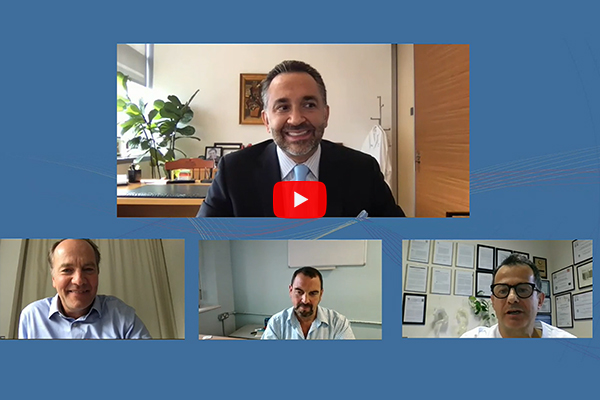
Ali Azizzadeh (top) chaired the CX 2020 LIVE Industry Symposium, which featured contributions from Hence Verghagen (bottom row left), Richard Gibbs (bottom row left), and Santi Trimarchi (bottom row right)
Benefits of using angulation control in thoracic endovascular aortic repair (TEVAR), an update on the management of acute, uncomplicated type B aortic dissection and thoughts on the influence of distal oversizing in distal stent graft-induced new entry in chronic dissection were discussed during the fourth session of CX 2020 LIVE. These were among the topics covered during an Industry Symposium—sponsored by Gore—titled “Advancing thoracic care” (session starts at timestamp: 01:02:15), which was chaired by Ali Azizzadeh (Los Angeles, USA), and included contributions from Hence Verhagen (Rotterdam, The Netherlands), Richard Gibbs (London, UK) and Santi Trimarchi (Milan, Italy).
Angulation control is “always” beneficial
Verhagen opened the session with a presentation explaining the use of the Gore ACTIVE CONTROL system, and when it is beneficial in TEVAR. Alongside angulation control, Verhagen explained, the device allows staged deployment which is intended to aid placement.
Verhagen offered details of the system in operation. In his words: “When you bring the device up to the desired position in the aorta, you turn the grey knob, pull it, and then you go into halfway partial deployment.” Displaying an image of the deployment in his presentation, he explained: “You are not perpendicular to the aorta here, as you can actually look into the circle proximally, instead of seeing it as a straight line.” After partial deployment, the C-arm can be readjusted after which a new angiogram can be made. Angulation control can be performed either at this stage, at full diameter deployment, or at both stages
“It makes you wonder when staged deployment is beneficial,” commented Verhagen, adding that “the answer in my mind is: always”. Explaining his rationale for this conclusion, he proffered that using staged deployment means that there is no “windsock” effect in the vessel; no tension build-up in the system due to tortuous anatomy, and it provides an opportunity to readjust the C-arm to make sure the image is actually perpendicular to the aorta without obstructing any blood flow.
On the benefits of angulation control, Verhagen suggested that there are three specific anatomies where it is “very useful”. This includes in tight arches, such as in blunt thoracic aortic injury and aortic transactions; in type 3 arch anatomy, and in tortuous anatomy, due to the added control and precision offered by the system, as well as improvements in wall apposition, orthogonality and prevention of bird beaking.
Verhagen presented the CX 2020 LIVE audience with results from the SURPASS registry which collected real-world clinical data and outcomes from the use of the Gore TAG Conformable Thoracic Stent Graft with ACTIVE CONTROL System. Angulation control was used in 50.4% of cases, he said, with 36% at intermediate diameter, 27% at full diameter and 37% in both. “The reason for use for every one (99%) was basically the same: to improve wall apposition,” Verhagen said.
In his concluding remarks, he suggested that the device allowed for both staged deployment as well as angulation control. Staged deployment with fixation of the device on the catheter ensuring “accurate placement proximally as well as distally,” and angulation control for optimal wall apposition. “In my mind this improves accuracy, as well as control, especially in challenging anatomy,” Verhagen summed up.
Current view on TEVAR for acute uncomplicated type B dissection
Following Verhagen’s presentation, Gibbs offered an update on the current management of acute, uncomplicated type B aortic dissection—considering when it is suitable to deploy TEVAR as a treatment option. Gibbs defined “uncomplicated” dissection as referring to patients who remain entirely stable, with no evidence of ongoing pain or malperfusion following their initial presentation.
Quoting data from the IRAD (International registry of acute aortic dissection), Gibbs commented that 90% of these patients leave hospital alive, whilst 10% develop acute complications during their inpatient stay. “The problem is that there is an increasing amount of data to suggest that patients initially treated medically, do not do well in the long term, with IRAD reporting mortality rates of up to 50% at five years due to aortic rupture,” he commented, adding: “This is of course, the group that develop chronic complications of type B dissection and undergo dilatation and aneurysm formation with the risk of rupture. We also know that compliance with strict antihypertensive regimes is poor, with less than half of patients reporting decent adherence to medication regimes.”
Discussing how to best manage acute uncomplicated type B dissection, Gibbs pointed out that there is currently a “paucity” of level 1 evidence in this particular field with two randomised trials reporting data—ADSORB which reported on acute uncomplicated type B aortic dissection patients, and INSTEAD, reporting on uncomplicated type B aortic dissection patients in the subacute and chronic phase. The former randomised patients with uncomplicated type B dissection to either best medical treatment or stent and best medical treatment , Gibbs explained, within 14 days of their indexed event. The trial was underpowered and did not show differences in mortality at one year, he noted. However, it did, he said, “demonstrate that stent graft usage was associated with a reduction in the false lumen diameter, and better rates of false lumen thrombosis with positive aortic remodelling”. The INSTEAD trial looked at chronic dissection patients, but had similar findings, Gibbs explained.
His presentation also touched on the European Society for Vascular Surgery’s guidelines for the management of descending thoracic aorta diseases, which were published in 2017. Picking out the key messages from the guidelines, Gibbs noted that medical therapy is always recommended as part of the treatment of acute type B dissection. He caveated this by pointing out that although the level of evidence for this recommendation is weak, the strength of the recommendation is high, suggesting that the treatment is beneficial and effective. “In terms of using TEVAR as a prophylactic procedure to prevent future complications in uncomplicated, acute type B dissection,” he said, “guidelines suggest that early thoracic endografting can be considered selectively, and that selectivity is predicated on anatomical and clinical features.”
Gibbs also commented that TEVAR carries the risk of “serious and sometimes lethal” potential complications, which can include retrograde dissection, deployment in false lumen, endoleaks, stent-graft induced new entry or stroke. He noted that the incidence of these complications increases with poor anatomical suitability for the procedure, adding that several treatment algorithms exist to aid assessment of patient suitability. Gibbs highlighted the DISSECT categorisation scheme—which sets out treatment options based upon risk and anatomical criteria.
In summing up, Gibbs said: “Offering TEVAR to anatomically suitable patients at the right time, one to two months after the index dissection event, when the dissection flap is mobile, seems to represent the most optimal form of treatment we can currently offer.”
Risk factors for SINE and device-specific differences
Closing the symposium, Trimarchi’s presentation covered distal oversizing. He focused on whether this is the sole reason for distal stent-graft induced new entry (SINE) in chronic dissection and examined whether there are device specific differences that may be contributing to the risk factors.
Trimarchi outlined findings from a meta-analysis of first generation endograft devices, which showed a cumulative incidence of stent-graft induced new entry of 7.9%. “For the devices used in these experiences it is reasonable to conclude that distal oversizing might increase the risk for distal stent-graft induced new entry,” Trimarchi suggested. Further results on second and third generation endografts were presented from the GREAT registry, showing a cumulative incidence of stent-graft induced new entry of 4%, both for acute and chronic dissection.
He also quoted from a meta-analysis from Ludovic Canaud et al published in the Journal of Vascular Surgery in 2019, where five studies of first generation endograft showed a rate of stent-graft induced new entry with distal stent graft oversizing of over 20%.
“Another important role has been attributed to the taper ratio of the thoracic aorta, which is defined as the ratio between the proximal and the distal diameter,” commented Trimarchi, noting that four studies quoted in the Canaud meta-analysis reported a significantly higher rate of stent-graft induced new entry, with a higher taper ratio of the thoracic aorta. In general, Trimarchi explained that Canaud et al’s meta-analysis showed that stent-graft induced new entry was symptomatic in only 5% of the patients admitted to the hospital for back or chest pain. He added that additional procedural intervention was adopted in all symptomatic patients or in those that showed an increase in the false lumen size. Secondary interventions were reported in six studies in 54% of the patients (n=53), the majority involving TEVAR (98%) and one open surgery.
Another area emphasised by Trimarchi was the tortuosity of the descending aorta. He told the CX 2020 LIVE audience that this is a particularly important consideration “in terms of inducing or favouring the incidence of a new aortic lesion”, once the patients has been treated with TEVAR. Trimarchi shared the findings of a paper which he had co-authored, (published in the World Journal of Surgery) that concluded that tortuosity in the descending thoracic aorta is more prominent in diseased aortas, especially in aneurysmal disease. “This phenomenon should be taken into account when we plan TEVAR in order to prevent graft-related complications and obtain positive long-term outcomes,” he commented.
Trimarchi then detailed a further study, evaluating the impact of aortic tortuosity on displacement forces in descending thoracic aortic aneurysms, which concluded that high tortuosity results in increased displacement forces in the distal aorta. “So, when we plan TEVAR again one more time we may potentially have increased the risk for stent graft-related complications in the presence of important angulation and tortuosity,” he said.
In his concluding remarks, Trimarchi noted that the incidence of distal stent-graft induced new entry ranged between 4–12% of patients after TEVAR for type B aortic dissection, arguing that the main determinant of such lesions seems to be the excessive distal oversizing, especially when considering a patient managed with a first generation graft. “A more extensive approach in the primary procedure and new generation grafts need to be investigated, in order to understand if they reduce distal stent-graft induced new entry incidence,” he said, adding: “We have to also take into account tortuosity and angulation, which have been proven to be associated with TEVAR complications, and as a consequence, might be involved in the distal stent-graft induced new entry origin.”
This coverage has been supported by an educational grant from Gore.









